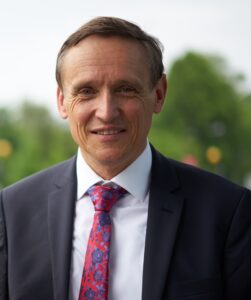Lecturer 2022:
Professor Dr. Jacques M. Huyghe
University of Limerick, Ireland
Eindhoven University of Technology, The Netherlands

Bio
Jacques Huyghe holds a Master degree in Civil Engineering from Ghent University, Belgium (1979)
and a Ph.D. from Eindhoven University of Technology, The Netherlands. Jacques Huyghe has a
unique signature in that he has been working at the interface between biomedical and petroleum
engineering. He advertised repeatedly the close analogies between biological tissues and
geomaterials and the urgent need to exploit these analogies in developing numerical models and
industrial/clinical technologies. He authors more than 125 full-size SCI-publications, is the recipient
of many awards among which a Royal Dutch Shell donation (1995-1998), a fellowship of the Royal
Netherlands Academy of Arts and Sciences (1996-2001) and a swelling materials Interpore Award
(2013). He has been cooperating with many industrial partners among which Philips Research, Shell
Research and Procter and Gamble. His present interest is in mechanotransduction through voltage
gated ion channels in intervertebral disc, swelling and fracture of superabsorbents and
poromechanical modelling of coronary blood flow and microvascular flow of red blood cells.
Lecture Options:
Hosts may select one of two options detailed below:
Lecture Option A:
Poromechanics in extremely large deformation: swelling and fracture.
Biomedical engineers face porous media with very low stiffness, high osmolarity and extremely large deformations. Examples are superabsorbent hydrogels and living cells. Volume strains above 1000 % strain are commonplace in diapers, female pads and growth plates. The strong nonlinearities of large deformation formulations of poromechanics hamper the use of analytical solutions. Large deformation u-p formulations fail in this regime [3]. This means that simulation tools of poromechanics are inapt to a great deal of biology, which typically unfolds in the intracellular space. Local mass balance violation is the culprit under extremely large deformations [1]. In order to address this issue, we developed a mixed hybrid formulation of poromechanics of swelling gel based on a Raviart-Thomas finite element [1-3]. This formulation strictly complies with local mass balance. Swelling computations are possible down to a shear modulus of 10 kPa. Surface instabilities easily develop as osmotic forces overtake the stabilising effect of the elasticity [2]. Fracture simulation using large deformation XFEM including flow within the crack, between the crack and the formation and within the crack, allows for initiation, coalescence and bifurcation of cracks [4,5]. XFEM computations predict experimentally observed staccato propagation of cracks in hydrogels [6]. Constitutive modelling of swelling require the concurrent use of elastic, mixing and ionic energies in Flory-Rehner swelling model [8]. Interaction terms between elastic and ionic energies occur because the stiffness of gels directly depends on ionic concentrations. [9-10]. Future perspectives on constitutive modelling of swelling and fracturing gels include herniation of intervertebral disc, mechanotransduction of extracellular matrix and design of biomimetic hydrogels. Hydraulic fracturing of shale is an important geotechnical application.
Lecture Option B:
The heart: the only pump the failure of which cannot be assessed through stress analysis.
Technological advances in computational mechanics allow to simulate failure of any part of airplanes, pumps, compressors, electric power stations, foundations, bridges, etc. Billions of dollars have been invested to calculate 3D stress configuration in engineering structures. Why stress? Because the criterion of failure in engineering structures is generally excess stress. Failure of the human heart is responsible for 6 million deaths per year worldwide. Models of cardiac mechanics have been developed to analyse cardiac pump function from tissue to organ scale. All of these models focus on stress and strain. [9] However, heart failure is not associated with fracture. Failure of a heart is usually induced by a mismatch between blood perfusion and metabolic needs of the cardiomyocytes. Blood perfusion is defined as the capillary blood flow per unit volume of tissue. Its dimension is ml s-1ml-1=s-1. Typical values at rest are 0.02 s-1[7]. Blood flows into the myocardium through a complex tree of arterial vessels, reaching a dense network of more than 3000 capillaries per mm2. A tree of venous vessels mostly parallel to the arterial tree drains the blood. Because failure is associated with blood perfusion and present day models do not address this failure mechanism [9], there is an urgent need for a computational strategy for blood perfusion in deforming myocardial tissue. Upscaling of the vessel trees [1-3,5] opens the way to computation of coronary blood flow in a multi compartment poro-mechanical model of the beating heart. Arterial, arteriolar, capillary, venular and venous blood are treated as separate compartments [3-8]. As a result, the supply of oxygen to the tissue is modelled. Combining this with a local metabolism and autoregulation, a precise criterion of failure is implemented to predict cardiac pathologies and the impact of interventions on heart function. Through the design of a virtual environment for testing cardiac interventions, the time to market of all newly designed devices and therapies will be shortened substantially.
How to request and host the InterPore Kimberly-Clark Distinguished Lectures
InterPore Foundation accepts applications from member and non-member organizations for hosting the InterPore Kimberly-Clark Distinguished Lecturer.
To request the presentation, please download and fill out the application form and return it to executive-officer@interpore.org with nomination@interpore.org in CC.
Lecturer availability will be limited and not all requests can be honored by the lecturer.
Should a physical presentation not be feasible because of travel restrictions due to the COVID-19 pandemic, lecturers will be available to give an online presentation.
